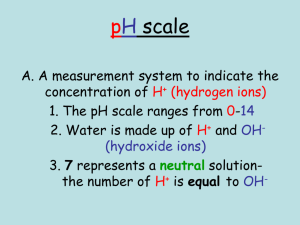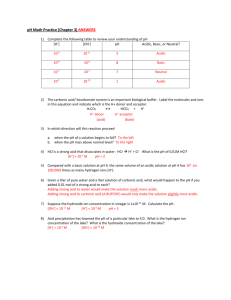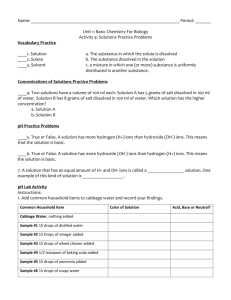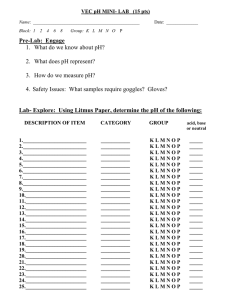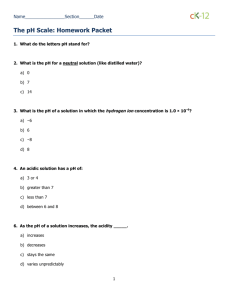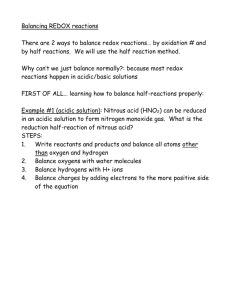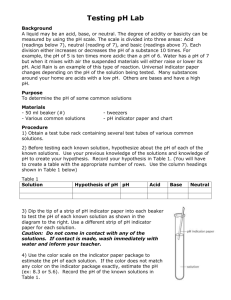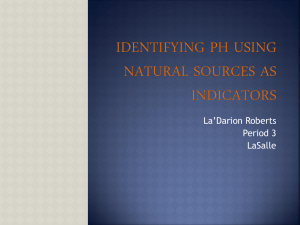Noam D Harari
advertisement
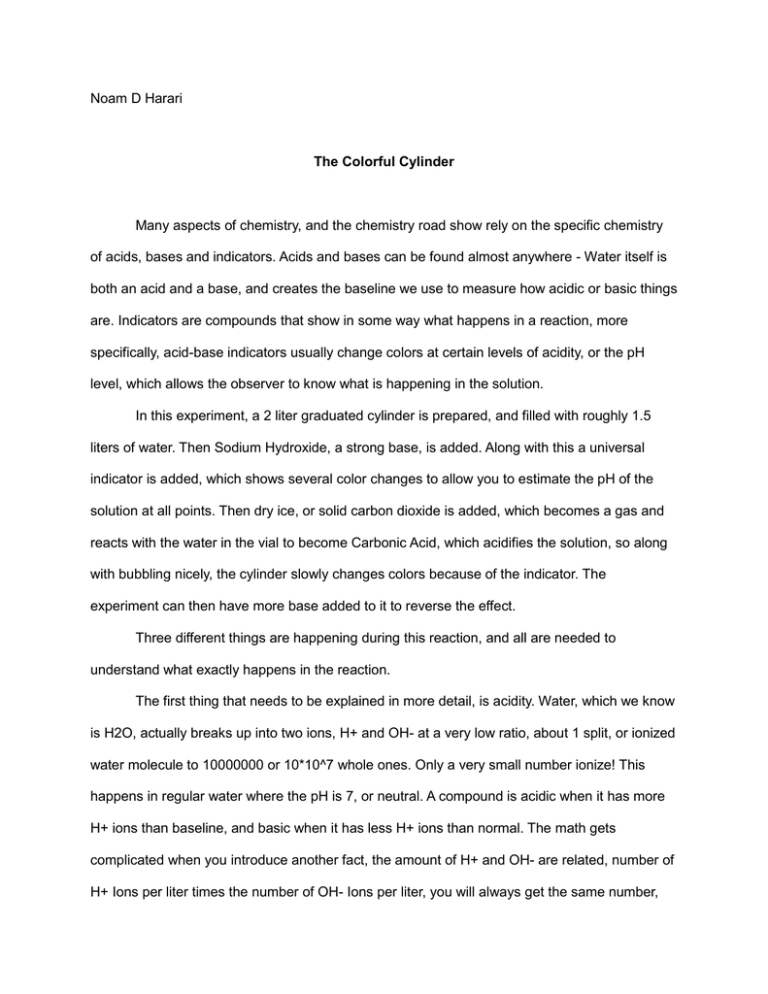
Noam D Harari The Colorful Cylinder Many aspects of chemistry, and the chemistry road show rely on the specific chemistry of acids, bases and indicators. Acids and bases can be found almost anywhere - Water itself is both an acid and a base, and creates the baseline we use to measure how acidic or basic things are. Indicators are compounds that show in some way what happens in a reaction, more specifically, acid-base indicators usually change colors at certain levels of acidity, or the pH level, which allows the observer to know what is happening in the solution. In this experiment, a 2 liter graduated cylinder is prepared, and filled with roughly 1.5 liters of water. Then Sodium Hydroxide, a strong base, is added. Along with this a universal indicator is added, which shows several color changes to allow you to estimate the pH of the solution at all points. Then dry ice, or solid carbon dioxide is added, which becomes a gas and reacts with the water in the vial to become Carbonic Acid, which acidifies the solution, so along with bubbling nicely, the cylinder slowly changes colors because of the indicator. The experiment can then have more base added to it to reverse the effect. Three different things are happening during this reaction, and all are needed to understand what exactly happens in the reaction. The first thing that needs to be explained in more detail, is acidity. Water, which we know is H2O, actually breaks up into two ions, H+ and OH- at a very low ratio, about 1 split, or ionized water molecule to 10000000 or 10*10^7 whole ones. Only a very small number ionize! This happens in regular water where the pH is 7, or neutral. A compound is acidic when it has more H+ ions than baseline, and basic when it has less H+ ions than normal. The math gets complicated when you introduce another fact, the amount of H+ and OH- are related, number of H+ Ions per liter times the number of OH- Ions per liter, you will always get the same number, .00000000000001 or 10*10^-14. This means, then when the number of H+ goes up, the number of OH- goes down, but the basic idea is that high H+ and low OH- means acidic, and low H+ and high OH- means basic. The second reaction is simpler. Carbonic Acid is a compound with the formula H2CO3, which is an acid because it releases two Hydrogen ions when it dissolves in water. So, when carbon dioxide dissolves in water, it creates a state where more hydrogens are floating around in solution, which makes it more acidic. The third reaction, is perhaps the most complicated. Most indicators work on a process called Conjugation. Conjugation is when there are double bonds in a molecule all near each other arranged in a way that lets them share electrons between them, which makes the whole molecule more stable. The acid base indicators change the amount of conjugation they have in acidic or basic conditions, a Hydrogen atom usually has to come or go and change something in the molecule. Conjugated bonds also do something else, absorb light. When there is more conjugation, the molecule is more stable, and absorbs lower energy light, like red, and when it is less conjugated, it absorbs higher energy light, like blue, or violet. A Indicator will then change color to another, based on the amount of conjugation, which is based on the acidity. And thats how this complicated (But extremely pretty!) reaction works. Something To Try At Home: Now, something that is really interesting, is that most indicators are naturally occurring and one of them, a universal indicator like the one we use, is actually really easy to get! Red Cabbage, Which you may or may enjoy, has Flavin, an Anthocyanin in it, a natural indicator, which can be used to experiment! Note: This should only be done with parental supervision. 1. Get some red cabbage, and cut it into squares about one inch by one inch. 2. Take a suitable pot or container, and place as much boiling water as you want indicator in it. 3. Place some cabbage in it, about 1 square for every cup of water you used (about a handful for a liter of water) 4. Let it sit until cool, then take some indicator out with a ladle, and put it in a small cup. 5. Now you can experiment! With your parents help, try adding some foods to it, like soda, lemon juice, milk, or anything else you can think of. Only use one small cup of indicator with each item you test, because it allows you to see the color change better, and it’s not a good idea to randomly mix chemicals! The Cabbage Juice will change colors according to the acidity. Very Acidic - Red Mildly Acidic - Purple Lowly Acidic - Violet Slightly Acidic - Blue Mildly Acidic - Blue-Green Very Acidic - Green For more information, check these websites: A more detailed version of the cabbage experiment http://chemistry.about.com/od/acidsbase1/a/red-cabbage-ph-indicator.htm For more information about acid - base chemistry http://chemistry.about.com/od/acidsbases/Acids_Bases_and_pH.htm For detailed information on carbonic acid http://www.chemspider.com/747
